코스모스: 왼쪽은 천재, 오른쪽은 미치광이
원작자: 비트레이시
보조 제목
1. 모놀리식 또는 모듈? 문제가 아니라 선택이다
어떤 종류의 네트워크가 생태계 발전, 모놀리식 구조 또는 모듈형 구조에서 더 많은 이점을 가지고 있습니까? 단일 칩 구조에서는 공유 컴퓨팅 환경으로 인해 응용 프로그램이 서로 유연하게 호출할 수 있으며 생태적 협업 및 스태킹을 실현할 수 있지만 단일 칩 구조는 정산 효율성 문제를 해결하기 어렵습니다. 나중에 동일한 영역의 여러 응용 프로그램이 블록의 컴퓨팅 공간을 놓고 경쟁하면 네트워크 성능이 모놀리식 구조에 의해 직접적으로 제한됩니다. 모듈 구조는 블록체인 네트워크 기능을 각각 독립적인 기능을 수행하는 여러 모듈로 분해하여 네트워크 리소스의 효과적인 할당을 실현하는 것입니다. 이러한 배열은 특정 상호 작용을 희생하지만 네트워크 운영 효율성을 효과적으로 향상시킬 수 있습니다.

단단히 짜여 하나로 되어 있는:더 큰 블록은 네트워크 용량을 늘리고, 노드 리소스 요구 사항을 늘리고, 탈중앙화를 희생하고, 합의 비용을 줄여 성능을 개선하고, 노드 운영을 제한된 데이터 센터로 제한합니다.
기준 치수:모듈식 체인은 총 워크로드를 서로 다른 노드로 분할하며 궁극적인 목표는 효과적인 리소스 가격 책정 및 분산화입니다.
과거 Layer 1 물결에서 네트워크 성능을 개선하는 방법은 투자자들이 항상 토론하고 싶어했던 주제였습니다. 2022년 9월 이더리움은 성공적으로 합병을 완료했으며, 리더인 Vitalik도 이더리움이 향후 Danksharding 형태로 네트워크 샤딩 및 확장을 완료할 것이라고 밝혔습니다. 메인 네트워크는 여전히 합의, 실행, DA의 기능을 동시에 유지하지만 트랜잭션 기반이 증가하는 맥락에서 탈 중앙화 네트워크의 컴퓨팅 리소스에 대한 수요가 점점 더 시급해지고 있습니다. 확장 + Rolls Up을 통해 일체형 구조에서 모듈로 이동하여 더 가까이 이동합니다. 거시적 관점에서 모놀리식 대 모듈식은 질문보다 선택에 가깝습니다. 생태 발전이 초기 단계에 있을 때 컴퓨팅 리소스는 발전을 억제하는 주요 요인이 아니며 사용자와 개발자는 좋은 상호 작용 경험이 필요합니다.이러한 관점에서 볼 때 모놀리식 네트워크는 초기 단계이며 대화형 스태킹 프로토콜에 의존합니다. 반대로 모듈식 퍼블릭 체인은 컴퓨팅 리소스에 대한 요구 사항이 높고 광범위하고 충성도가 높은 사용자 기반을 가진 단일 애플리케이션에 더 적합합니다.
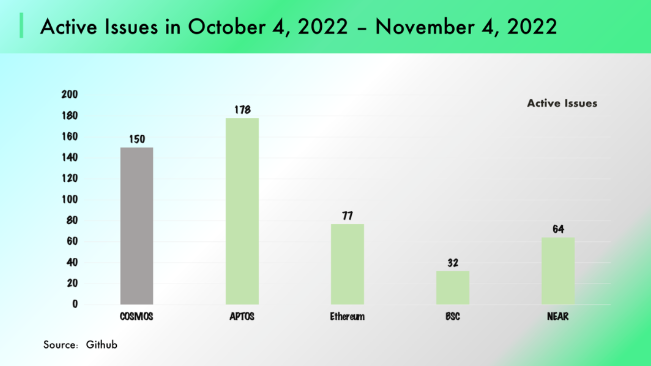
보조 제목
2. 코스모스 네트워크 구조
블록체인 네트워크의 기능 계층은 크게 합의 계층, DA 계층 및 애플리케이션 계층으로 나눌 수 있습니다. 2016년에 출시된 퍼블릭 체인인 코스모스는 현재 대부분의 블록체인과 다릅니다. 먼저 Cosmos는 개발자에게 합의 메커니즘과 애플리케이션 도구(SDK)를 제공하지만 실행 엔진(가상 머신)은 제공하지 않습니다.이러한 설계는 개발자가 애플리케이션 체인의 컴퓨팅 환경과 트랜잭션 유형을 정의할 수 있음을 의미합니다. Cosmos가 합의 레이어와 애플리케이션 레이어를 설정한 후 개발자는 ABCI(Application Blockchain Interface)를 통해 애플리케이션 레이어와 컨센서스 레이어를 연결할 수 있습니다. 따라서 Cosmos는 블록체인 네트워크 도구 집합에 가깝습니다 개발자는 Tendermint 합의 메커니즘과 Cosmos SDK를 사용하여 블록체인 네트워크를 구축하거나 애플리케이션 요구에 따라 스마트 계약을 위한 가상 머신을 구축할 수 있습니다.

즉, 이더리움은 기업과 유사합니다. 각 사업부서는 회사의 규정(블록 생산 속도, 가스 소비량, 운영 공간)을 준수하여 사업을 운영해야 합니다. 각 부서는 서로 협력하고 자원을 공유할 수 있습니다. 동일한 네트워크(가상 머신에서). 코스모스는 공업단지에 가깝고 기업은 입주 후 비즈니스 요구에 따라 업무 지침을 수립하고 자체 개발 방식을 모색할 수 있습니다. 공원은 인프라(Tendermint) 및 생산 도구(SDK) 제공을 담당합니다.
코스모스 구성: SDK, IBC, Tendermint
Cosmos SDK: Polkadot의 Substrate와 유사한 퍼블릭 체인 구성 툴킷 및 템플릿 라이브러리. Cosmos SDK는 애플리케이션에 필요할 수 있는 기능을 여러 모듈로 분할하므로 개발자는 애플리케이션 체인 요구 사항만 통합하면 됩니다.
IBC: 네트워크의 모든 영역과 허브에 대한 합의를 제공하는 퍼블릭 체인 간의 통신 프로토콜 체인을 시작하는 사용자는 트랜잭션을 확인하고 교차 체인 상태 확인을 실현하기 위해 계정 서명과 Merkle Root를 업로드하기만 하면 됩니다.
Cosmos Hub: Zone은 Hub에 의존하여 IBC를 통해 서로 연결되며, Zone이 충분한 생태계와 연결되어 있으면 Hub로 식별할 수 있습니다.
요약하다:
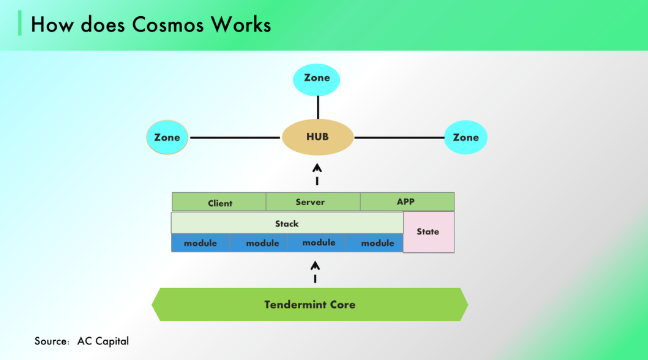
요약하다:보조 제목
3. 코스모스만의 특징을 가진 부분학생
최적의 네트워크 구조는 무엇입니까? 이 점에 대한 정확한 답은 없습니다.모듈형 네트워크는 자연스럽게 성능면에서 이점이 있지만 통화 상호 작용은 모놀리식 체인만큼 좋지 않습니다. Cosmos는 완전한 기능을 갖춘 부분 과학 학생으로, 각 체인에 완전한 자율성을 부여하면서 개발자의 작업량을 줄일 수 있다는 것이 강점입니다.
장점: 유연성, 성능, 개발자 친화성
성능: 애플리케이션은 자체 실행 환경을 가질 수 있으며 필요에 따라 블록 시간, 처리량 등을 설정할 수도 있습니다.
이점: AppChain은 사용자와 직접 경제 활동을 수립할 수 있으며 프로젝트 측은 Gas를 통해 퍼블릭 체인에 수수료를 지불할 필요가 없습니다. 이는 개발자에게 프레임워크를 무료로 제공하는 Cosmos Network와 같습니다.
유연성: 애플리케이션 체인을 독립적으로 개발하려면 많은 노력과 비용이 필요하며 SDK 개발 팀은 중복 작업을 줄입니다.
단점: 상호작용, 보안
상호 작용: 독립적인 운영 환경은 프로토콜이 서로를 직접 호출할 수 없음을 의미하므로 유동성과 데이터 가용성이 분리됩니다.사용자는 단일 트랜잭션을 통해 여러 프로토콜을 사용할 수 없으므로 일부 프로토콜(DeFi) 개발에 매우 불리합니다. .
요약하다:
요약하다:보조 제목
4. Ten Dynamics에서 Cosmos 2.0을 거부한 이유는 무엇입니까?
코스모스 팀은 2022년 9월 Cosmosverse 컨퍼런스에서 백서 2.0 버전을 공개하여 Hub 네트워크 취약성과 ATOM 활용 부족 문제를 개선하고자 새로운 네트워크 모델의 주요 목적은 다음 세 가지 목표를 달성하는 것입니다.
(1) Hub를 Chain의 중심 위치로 확정
Cosmos 2.0은 Interchain Scheduler 및 Interchain Allocator(인센티브 모델이 그다지 공격적이지 않음)를 통해 유사 플라이휠 메커니즘을 생성하여 Cosmos 네트워크에서 허브의 핵심 위치를 통합하기를 희망합니다.
인터체인 스케줄러는 인터체인의 MEV 가치를 포착합니다: 인터체인 상호작용을 위한 MEV 시장을 만들고, 검증 노드는 크로스체인 TX 검증을 위한 집단 입찰을 수행하고, 인터체인 스케줄러는 인터체인 경제 활동에서 가치를 포착하기 위해 매칭 수수료를 부과합니다.
Interchain Allocator는 Hub에 권한을 부여합니다: Hub에 축적된 MEV 수입은 Cosmos 생태계 구축에 사용되며, 이 부분의 가치는 Interchain Allocator를 통해 Cosmos Hub의 자산에 유망한 새 프로젝트를 추가합니다. 결과적으로 이러한 프로젝트는 스케줄러의 잠재 시장을 확장합니다.
Interchain Scheduler 및 Interchain Allocator는 Cosmos Network 및 IBC 통신의 개발로 향상될 수 있습니다. Cosmos 2.0은 토큰화된 교차 체인 블록 공간 시장을 사용하여 자원을 허브로 기울임으로써 동형 체인에서 지배적 위치를 확립합니다.
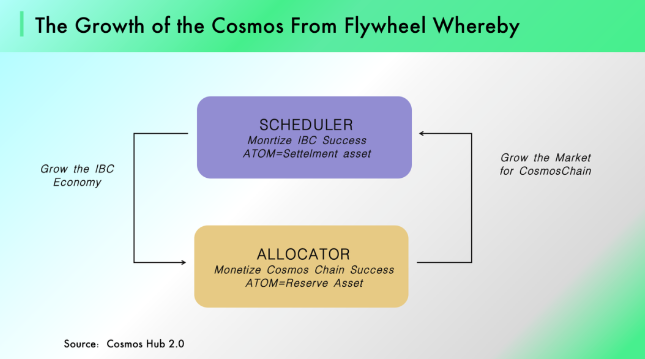
(2) 다양한 분배 메커니즘을 통해 ATOM에 대한 가치 지원 제공:
Bittracy에 따르면 Cosmos와 Polkadot의 가장 큰 차이점은 Muti-Chain이 안전하고 일관성이 있는지 여부입니다. Polkadot의 모든 다중 체인 거래는 메인 네트워크 POS를 통해 검증되어야 하며, Sub-Chain의 커뮤니티 구축은 DOT에 대한 수요를 직접적으로 창출합니다. 반대로 ATOM은 그 반대입니다.AppChain의 POS는 Zone 네트워크의 네이티브 토큰을 통해 확인되며, ATOM과 완전히 분리되어 AppChain의 번영이 Hub에 피드백할 수 없습니다. 지난 2년 동안 강세장을 돌아보면 2021년 Terra의 폭발적인 성장은 Hub와 ATOM에 긍정적인 영향을 미치지 못했습니다. 체인 간 보안 규칙에 따라 AppChain은 ATOM으로부터 보안을 얻을 수 있습니다. 즉, 보안을 보장하기 위해 기본 토큰 POS 노드와 ATOM 노드에서 체인의 상호 작용을 이중으로 확인합니다. 한편으로는 ATOM의 가치 수요를 증가시키고, 다른 한편으로는 스타트업 애플리케이션 체인의 보안에 매우 도움이 됩니다.
더 중요한 것은 새로운 규칙에 따라 Cosmos Hub는 ATOM과 크로스 체인 혁신 프로젝트 간의 경제적 조정 전략을 공식화하는 다양한 방법으로 외부 네트워크를 도울 수 있으므로 ATOM의 유용성이 생태계의 성장과 일치하도록 합니다. 그러나 새로운 메커니즘 하에서도 네트워크는 개발자가 ATOM의 보안을 사용할 것을 요구하지 않으며 ATOM은 Zone 구축에 필요하지 않습니다.
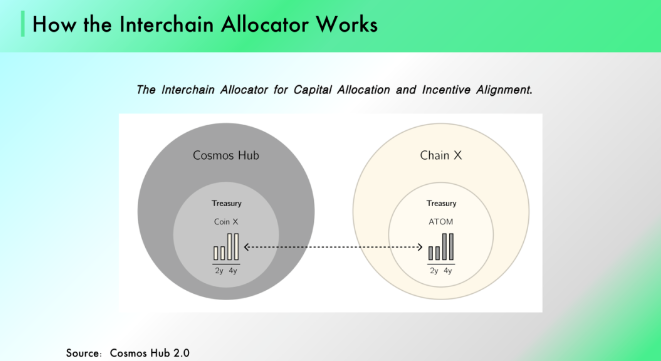
(3) 스테이킹 수익률 변경, 통화 보유자의 이익 희생, 이 재단을 사용하여 창업 자금 제공
Cosmos 2.0은 ATOM의 할당 메커니즘을 다시 계획합니다. 새로운 할당 메커니즘은 전환 및 정상 상태의 두 단계로 구성됩니다. 이 제안은 단기 자금 공급을 늘려 재무부의 초기 자금을 늘리는 동시에 토큰의 릴리스 곡선을 변경하여 토큰 릴리스의 총량을 줄이기를 희망합니다.
단기 인플레이션: 전환 단계가 시작될 때 매달 10,000,000개의 ATOM이 발행됩니다. 발행은 36개월 후 정상 상태에 도달할 때까지 감소율로 감소하여 매월 300,000 ATOM을 릴리스합니다. 첫 9개월 동안 ATOM의 인플레이션율이 원래 인플레이션율에 비해 크게 증가하고 새로 출시된 토큰이 Cosmos Hub Treasury로 유입되어 초기 자금을 조달할 것임을 알 수 있습니다.
화폐 총량 감소: 커뮤니티는 대규모 자금 풀을 효율적으로 관리하는 데 필요한 사회적 기반 시설을 개발할 기회가 있습니다. 전환 단계는 코스모스가 새로운 통화 정책으로 전환하는 순간부터 시작하여 안정 상태 단계가 시작되고 무기한 지속되는 36개월 후 종료됩니다. 제안된 새로운 발행 모델은 기하급수적 성장에서 선형 성장으로 전환될 것입니다. 총 통화의 관점에서 ATOM의 총 공급량은 원래 모델에 비해 크게 줄었습니다.
분권화된 세상에서 가장 매력적인 슬로건은 민주주의와 공정성입니다. 그리고 이 새로운 Cosmos 2.0 토큰 설정은 의심할 여지 없이 매우 중앙 집중화되어 있습니다. 이는 커뮤니티가 강제로 코인권을 사용하여 사용자의 권리와 이익을 약탈하여 ATOM 보유자의 이익을 직접적으로 손상시키는 것과 같습니다. 더 중요한 것은 이것이 분권화의 내러티브에 완전히 반대된다는 것입니다. 이 시간 이후에 다음 번이 없다고 누가 장담할 수 있겠습니까? 따라서 코스모스 2.0 발표 이후 ATOM의 가격 대비 성능은 보통 수준이었습니다.
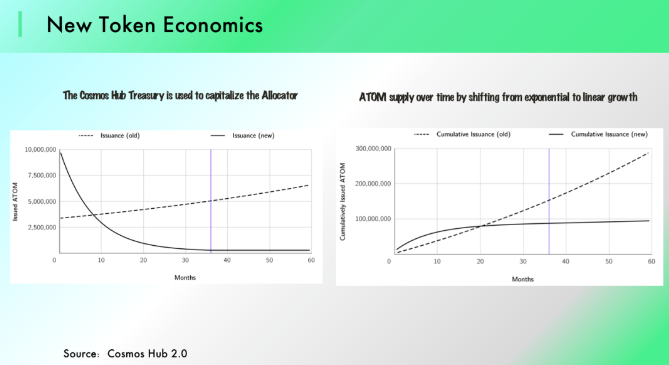
(4) 가치 분배가 고르지 않고 커뮤니티가 거부합니다.
보조 제목
5. 코스모스의 가치를 이해하는 방법
(1) 퍼블릭 체인의 가치를 이해하는 방법: Gas의 가치 평가 방법
퍼블릭 체인의 가치는 어디에 있습니까? 수익 모델의 관점에서 GAS & MEV는 퍼블릭 체인의 주요 수입, 즉 개발자와 사용자가 프로그램을 실행하기 위해 퍼블릭 체인에 지불해야 하는 수수료입니다.
Revenue = Throughput x $ users will pay for individual transactions
퍼블릭 체인의 상호 작용 활동이 왕성할 때 사용자는 기본 토큰에 대한 수요가 있을 것입니다.이 논리가 사실이라면 TPS가 높은 퍼블릭 체인은 수익이 적고 토큰 가치가 낮아집니다.이것은 반대입니다. 실제 상황. 따라서 우리는 단순히 GAS & MEV 수익을 통해 퍼블릭 체인의 가치를 측정할 수 없습니다.
(2) 가정이 잘못된 것 같다
Bittracy의 관점에 따르면 퍼블릭 체인의 가치는 네트워크 가치를 창출하는 능력에 있으며 토큰은 퍼블릭 체인 경제의 비인플레이션 통화에 더 가깝습니다. 구체적으로 퍼블릭 체인의 발전은 체인에 대한 경제 활동의 발전에서 비롯되며, 자산이 생성되면 퍼블릭 체인 토큰의 매우 중요한 역할은 개발자가 창출한 경제적 가치를 떠맡는 것입니다.
취급 수수료는 실제로 퍼블릭 체인의 가치의 원천이므로 우리는 이 공식을 부정하지 않습니다.
Revenue=Throughput * Users Transaction Fee
그러나 문제는 다음과 같은 암묵적인 가정입니다.
Token Value = Revenue
사실 인증서의 가치는 퍼블릭 체인의 수익과 같지 않습니다.
Token Value ≠ Revenue
토큰의 가치는 전적으로 퍼블릭 체인의 수익에서 나오지 않으며, 퍼블릭 체인의 수익은 토큰의 가치에 영향을 미치는 첫 번째 요소가 될 수도 없습니다. 먼저 토큰 값에 대한 파생 공식을 대담하게 작성해 보겠습니다.
Token Value = Token Demand / Circling Token Numbers
그 중 토큰에 대한 수요는 다음과 같습니다.
Token Demand = Speculation Value + Fundamental Value + Gas Value + Liquidity Value+Others
그 중 유통되는 토큰의 수는 계약의 운영에 따라 변경됩니다.
Circling Token Number =Circling Token Numbers + Releasing Tokens — Staking Tokens — Burning Tokens
따라서 퍼블릭 체인의 수익은 퍼블릭 체인 인증서의 가치와 완전히 일치하지 않으며 둘은 직접적인 인과관계가 없습니다. 토큰에 대한 수요에서 시작하여 토큰의 투기적 가치는 시장 상황과 높은 상관관계가 있습니다. 가격에서 뺀다. Fundamental Value의 경우 퍼블릭 체인 토큰의 기본 가치는 체인의 자산 가격 책정에서 비롯됩니다.예를 들어 Ethereum의 가치는 DeFi, NFT 및 GameFi가 구축한 경제 생태계와 EVM Side Chain/ 레이어 2는 제공되는 가치 지원을 제공합니다. 그 유명한 NFT, DID, Token 자산은 모두 AMM의 형태로 ETH를 통해 가격이 매겨지는 것을 볼 수 있습니다.즉, ETH는 Ethereum이 만든 디지털 자산의 통화 표현입니다. Gas Value는 사용자 수 및 네트워크 성능과 밀접한 관련이 있으며 토큰의 가치는 분자 및 분모 측면에서 모두 증가합니다.
Cosmos의 문제는 기본적으로 ATOM의 기본 가치가 없다는 것입니다.유사한 Avalanche 및 Polkadot과 비교할 때 개발자는 Hub 및 ATOM을 완전히 우회하여 자체 생태계를 구축할 수 있습니다.Terra의 온체인 자산 가격은 LUNA가 전적으로 부담합니다. 동시에 우수한 성능을 가진 블록체인 네트워크로서 빈번한 사용자 트랜잭션이 가격을 올릴만큼 충분한 Gas Value에 기여하기 어렵습니다.
코스모스 퓨처 위너스
그렇다면 코스모스 퍼블릭 체인은 어떻게 가치 창출을 달성할까요? 원래 2.0 백서는 과도한 인플레이션을 통해 칩의 분배를 변경하고 공개 체인을 구축하기 위해 재무부의 부를 늘리는 것을 선택했지만 채굴권 남용은 실제로 사용자와 개발자의 이익을 해쳤고 이는 커뮤니티에서 거부되었습니다. . 가치 창출의 경로는 다음과 같아야 합니다. 퍼블릭 체인은 자체 혁신 기능을 통해 네트워크 생태 구축을 촉진하고 가치 창출 및 경제 활동 성장을 실현할 수 있습니다. 이것은 사용자와 개발자를 결합하여 커뮤니티를 형성할 수 있을 뿐만 아니라 네트워크 생태계의 고품질 개발을 달성할 수 있습니다.
6. 요약
6. 요약
퍼블릭 체인 생태계의 발전은 항상 다소 형이상학적이었습니다.Solana 및 Aptos와 같은 유럽 및 미국 퍼블릭 체인은 먼저 퍼블릭 체인(높은 시장 가치, 낮은 순환)을 자본화한 다음 협업 네트워크의 발전에 맞춰 토큰을 출시합니다. 경제 활동의 필요에 따라. 후속 조치를 살펴보면 생태 혁신의 지속적인 협력 없이는 순수한 투자 가치가 사용자 유지를 달성할 수 없습니다. 다행스럽게도 Cosmos 는 이미 우수한 제품을 충분히 보유하고 있으며, 건실한 이과생처럼 필요한 것은 대내외 경제적 인센티브를 명확히 하는 것입니다.다행히 시장은 현재 평평하고 그가 제고할 시간이 충분합니다.
견적 링크
https://members.delphidigital.io/reports/finding-a-home-for-labs
https://members.delphidigital.io/reports/the-complete-guide-to-rollups
https://members.delphidigital.io/reports/valuing-layer-1 s-memes-money-or-more
https://research.paradigm.xyz/cosmos-thesis



